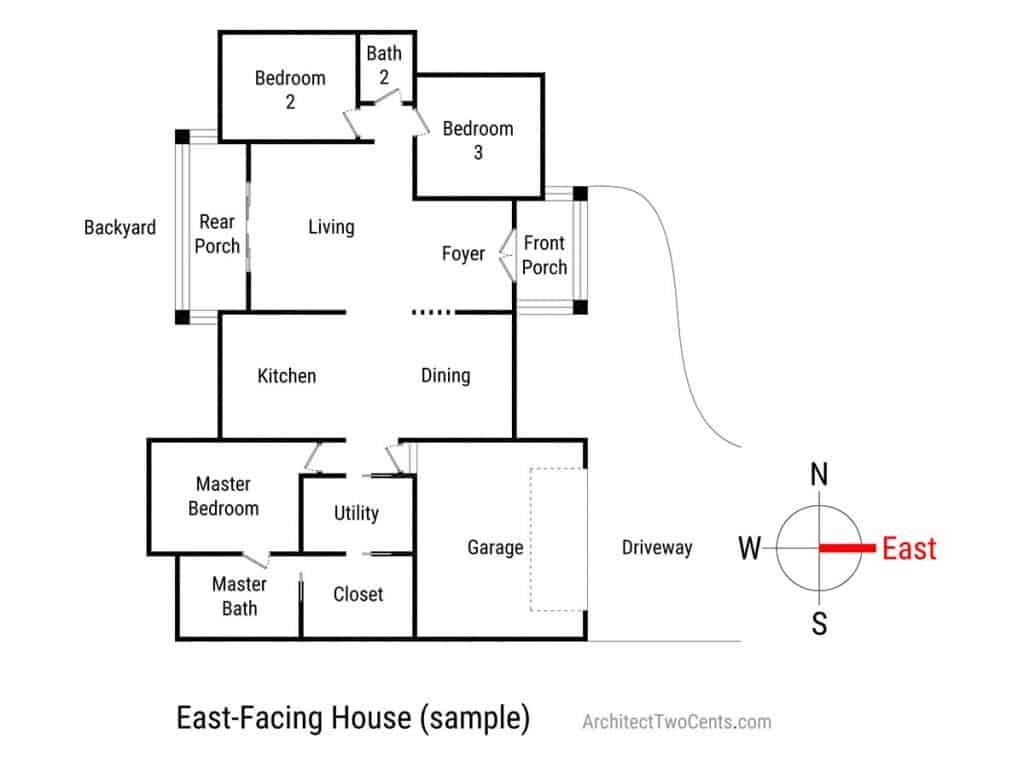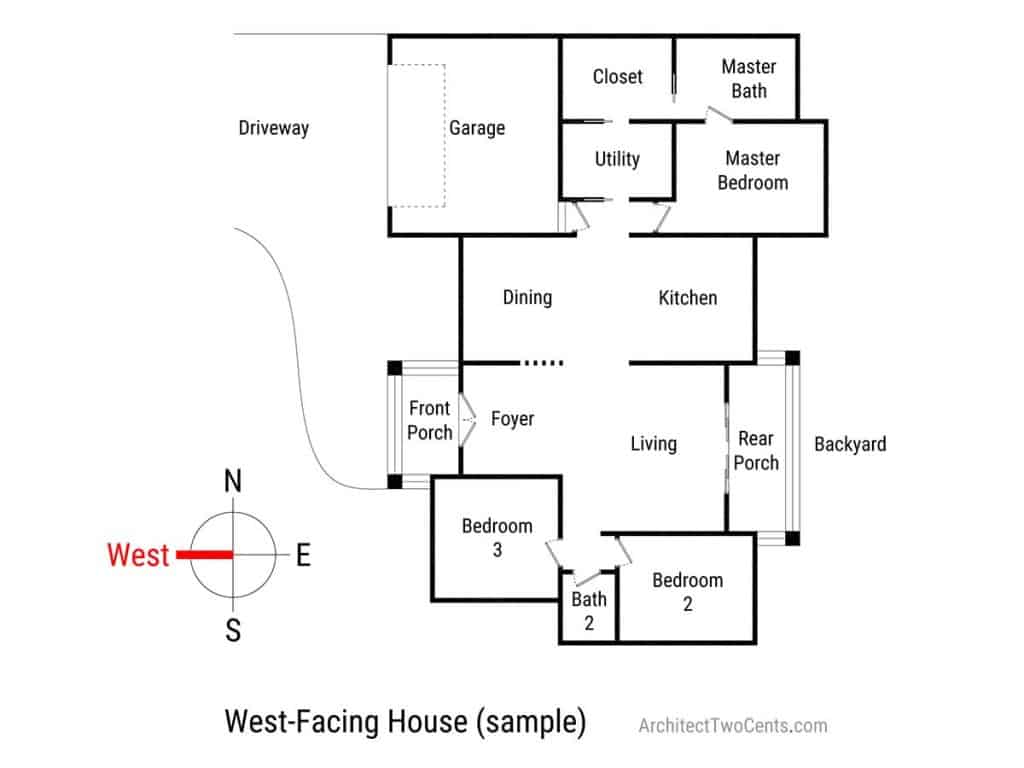North, South, East, West Facing? (Answers + Sample Plans)
Depending on a house’s location and the landscape and structures surrounding it, north, south, east, or west-facing brings its distinct set of pros and cons.
What does it mean if a house faces a particular direction when you house-hunt?
How do you find out the direction of your house or bedroom?

North-Facing
A north-facing house in the southern hemisphere (Australia and NZ) benefits from the winter sun to warm the home.
But for those in the US, UK, and Canada, a house or bedroom facing North suffers from poor natural lighting, particularly in winter when the sun is low on the horizon in the opposite direction.
What Does It Mean When a House Faces North?
A residential building that faces north has these features:
- The driveway and garage are at the north end of the house.
- When you open the front door and stand inside looking out, you face north.
- The backyard is at the south end.
How to Know If Your Home Is North-Facing?
There are several methods to find out.
A digital compass on your cell phone:
- Face your phone upward, with the top of the phone pointing towards the direction you are looking – you should be facing where the driveway or front yard is.
- Your house is facing north when the top marker reads between 330 and 30 degrees.
- If it reads 30 to 60 degrees, your house is facing northeast.
- If it reads 300 to 330 degrees, your house is facing northwest.
To check if your house is north-facing the old-fashioned way without a compass:
- In the morning (9-10 am): Locate the sun’s direction; turn 90 degrees to your left, and that is North. If you are also facing the front door and driveway from inside the house, then your home is north-facing.
- In the afternoon (2-3 pm): Locate the sun’s direction; turn 90 degrees to your right, and you are facing North. If that is the same direction as the front door and driveway looking from the inside, your home is north-facing.
Sample Floor Plan: North-Facing House

South-Facing
Residential buildings that face the south direction profit from the sun’s lighting when it is at an angle during winter, provided no taller buildings obstruct it.
What Does It Mean When a House Faces South?
A home is south-facing when:
- The street from which you drive in and the front porch are at the south end of the house.
- The backyard is at the opposite end of the property.
- You stand in your living room looking southward, and you see the front porch and driveway.
How to Know If Your Home Is South-Facing?
Again, you have more than one way to find out.
Using a digital or physical compass:
- Point the top of the phone or physical compass in the direction you face; the phone should face up.
- You should face in the direction of the street and driveway.
- The house faces south if the top marker is between 150 and 210 degrees.
- If the reading is between 120 to 150 degrees, it is southeast-facing.
- If the reading is between 210 and 240 degrees, the house faces southwest.
Without a compass:
- In the morning (9-10 am): Determine the sun’s direction; turn 90 degrees to your right, and that is the south direction. Your property is south-facing if you are also looking in the street and driveway direction from inside the house.
- In the afternoon (2-3 pm): Check where the sun is; turn 90 degrees to your left, and you are facing south. The house is south-facing if that is the same direction as the driveway.
Sample Floor Plan: South-Facing House

East-Facing
Rooms that face the eastern direction enjoy the morning sun rays filling the indoors – but an annoyance for late risers.
What Does It Mean When a House Faces East?
A house is east-facing when:
- The street and driveway are at the east end of the property.
- The backyard is at the west end.
- When you stand inside the house and look eastwards, you see the driveway.
How to Tell If Your Home Is East-Facing?
Using a digital compass on your phone:
- The phone should face up, and the top of the phone should point in the same direction you face.
- You need to face the street and driveway direction.
- The house is east-facing when the top marker falls between 60 and 120 degrees.
- If it reads between 30 to 60 degrees, the house is northeast-facing.
- If it reads between 120 and 150 degrees, the property is facing southeast.
Choose almost any time during the day when the sun is shining, except midday:
- In the morning (9-10 am): Check the sun’s direction. If it is in the same direction as the driveway, your house faces east.
- In the afternoon (2-3 pm): Check where the sun is. Turn to your opposite direction (180 degrees), and if you are also facing the street and driveway, the house is east-facing.
Sample Floor Plan: East-Facing House

West-Facing
Windows and openings that face west suffer from the sun’s heat when temperatures are highest in the day.
This drawback becomes advantageous in winter when heat gain warms the house and reduces energy consumption.
What Does It Mean When a Home Faces West?
Features of west-facing houses:
- The front door, driveway, and street are at the west end of the property.
- The backyard lies at the eastern end.
- The front porch faces the afternoon sun direction.
How to Tell If Your House is West-Facing?
Download and use a digital compass on your phone:
- Face the phone upwards with the top pointing in the same direction you face.
- From inside the house, you must point yourself towards the street or driveway.
- The house is west-facing if the marker reads between 240 and 300 degrees.
- If the reading falls between 300 and 330 degrees, the house faces northwest.
- If the reading falls between 210 and 240 degrees, the house faces southwest.
Choose any time in the day to observe the sun’s direction, but avoid midday:
- In the morning (9-10 am): The opposite to the sun’s direction is the west – if the street and driveway are in that direction, the house is west-facing.
- In the afternoon (2-3 pm): If the sun’s direction is the same as the front door and driveway from inside the house, your home is facing west.
Sample Floor Plan: West-Facing House

What About the Rooms?
Rooms and bedrooms typically have windows only on one side of the walls, so the benefits of a specific facing depend on their use and time of day.
Is Your Room North or South Facing?
You can quickly identify an east or west-facing room by the time it receives direct sunlight: east-facing in the morning and west-facing in the afternoon.
It is more challenging to know if your room is facing north or south when the direction it faces falls precisely on the north-south axis as you can’t see the sun from inside the room.
It is easy if you have a digital compass. Face the side of the room with the most windows:
- If the compass reads between 330 to 30 degrees, your room is north-facing.
- If the compass reads between 150 and 210 degrees, your room is south-facing.
Alternatively, look outside the window:
- Between 8-10 am: see the direction of the shadow a structure or tree casts; 90 degrees to the right of that shadow (imagine the bird’s eye view) is the north.
- Between 2-4 pm: again, observe the direction of the shadow; 90 degrees to the left of that shadow is the north.
Should Bedrooms Face North or South?
The benefits and drawbacks of a room facing depend on its use and your lifestyle.
If you are an early riser and also work in the room, a south-facing bedroom is advantageous because it enjoys natural lighting for longer in the context of a year.
Plus, you use less energy for heating in winter.
If you are a late riser, you will be happier with a north-facing bedroom as the room faces away from direct sunlight.
In winter, the heating bills may be higher, but it isn’t significantly so.
What Rooms Should Face North?
North-facing rooms experience less sunlight and lower heat gain during summer.
Ideally, these rooms should face north:
- Master and other bedrooms.
- Kitchen.
- Utility.
- Bathrooms
Which Rooms Should Face South?
South is the ideal facing for houses in the northern hemisphere (US, UK, Canada) because the increased sun exposure in winter enhances natural lighting indoors.
You should aim to have these rooms facing south:
- Living (or Great Room).
- Dining.
- Guest bedroom.
- Home office.
How to Find the North, South, East, and West Directions in a Room?
Finding the cardinal direction in a room is easy with a digital compass.
If you don’t have a compass, you can match the sun’s path with the time of day:
- The north direction in a room: when you face the windows, the sun rises on your right and sets on your left. Additionally, the morning sun casts a shadow to the left of an object from where you see it.
- The south direction in a room: the opposite of north.
- The east direction in a room: if direct sunlight enters the room in the morning, the direction from which the sun shines is the east. Conversely, you see a long shadow outside your room’s window between 3-5 pm – your room faces east.
- The west direction in a room: a long shadow forms outside the window between 8-10 am, or you get direct sun rays through the window in the afternoon.
References:
https://www.wikihow.com/Determine-Directions-to-North,-South,-East,-and-West
https://www.mathsisfun.com/measure/compass-north-south-east-west.html
https://www.geographyrealm.com/understanding-direction-based-sun/
